HATCHET
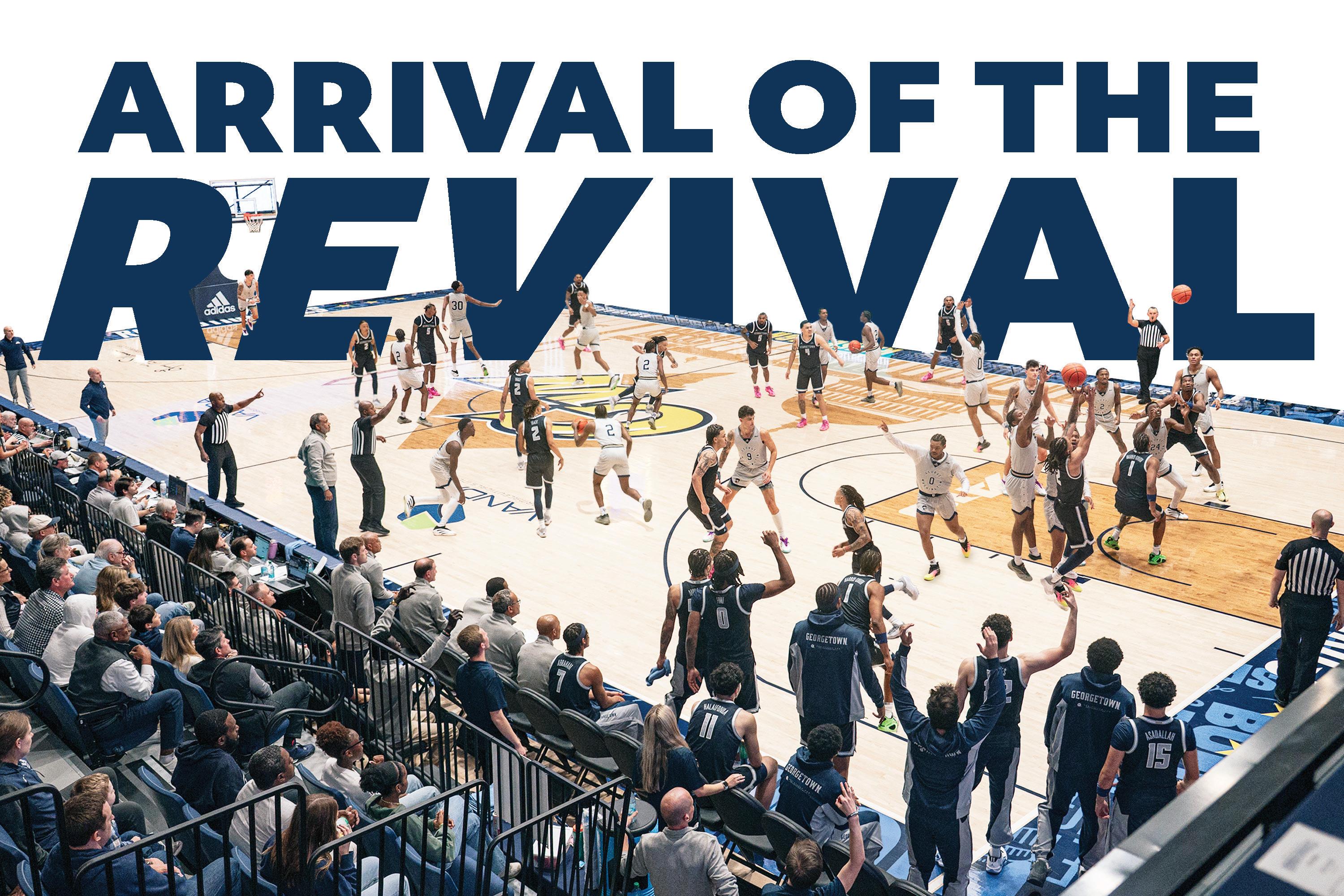
BASKETBALL GUIDE 2025
After years of rebuilding, men’s basketball enters season with real shot at A-10 crown
After finishing last season with their best record in a decade, signs are pointing up for men’s basketball as they head into this year.
Entering the season picked fourth in the Atlantic 10 and earning top-85 national rankings in Kenpom and BartTorvik, there’s legitimate expectations for the team to contend in the conference this year. Head Coach Chris Caputo said after a practice in October that being in the A-10 Championship hunt is a “privilege” and is something the team hasn’t experienced in the three years he’s been at its helm.
“For us, being relevant in basketball is really important,” Caputo said.
There’s good reason for the team to have this offseason hype. After a 21-13 season that earned the squad a bid to the newly-formed College Basketball Crown, the team retained its best player — forward Rafael Castro — who led the team in scoring last year and earned a Second Team AllA-10 nod. The team also welcomes an impressive crop of transfer players who add significant depth to the roster. Tre
Dinkins III will play his sixth year of collegiate basketball — which includes two at the junior college level — this season at GW. At A-10 rival Duquesne last year, he scored in double figures in 25 of the team’s 32 games, a consistency in scoring he looks to bring to Foggy Bottom.
Dinkins is joined by former Hofstra University junior guard Jean Arangunen, former Western Kentucky University forward graduate student Tyrone Marshall Jr., former Northwestern University forward graduate student Luke Hunger and former Tarleton State University guard junior Bubu Benjamin.
Perhaps the key to this year’s lineup is the return of redshirt junior forward Garrett Johnson, who missed the entirety of last season with a torn ACL. After over a full year of rehab — which also included returning to chemotherapy treatments for a benign hip tumor — Johnson said in an interview he feels “pretty good” heading into the season.
Johnson’s return will be key for the team’s success behind the 3-point line. In the 2023-24 season, he led the team shooting 40.3 percent from behind the arc.
The first real test for the team comes just two games
For the first time in a decade, GW men’s basketball enters a season not fighting to stay afloat but fighting for a title. This year’s squad boasts a fourth-place preseason rank among Atlantic 10 competitors. The significance? GW hasn’t finished in the top four of the conference since 2014, but this team has the tools — and expectations — to break that drought.
With a top-60 ranking in Barttorvik and co-favorite BetMGM odds with Virginia Commonwealth to win the conference, metrics say the Revolutionaries are ready to contend. So do I. Anchored by redshirt senior forward Rafael Castro, a pre-
into the season, on Saturday against the University of South Florida at a neutral site in Connecticut. A big win this early would show these lofty expectations are backed up by substance and point the team’s trajectory even higher.
Far and away the team’s best opponent is the University of Florida — the reigning national champions — whom GW is scheduled to play on Dec. 13 in Sunrise, Florida. The matchup with the Gators will be the team’s last Division I game before conference play, which is marked by nine nationally-televised appearances, including a Feb. 27 Friday night ESPN-aired game against Dayton, their first in eight years.
These TV spots and premier matchups are significant, signaling a program on the rise and a team that thinks it’s ready to make the jump into contention. For Caputo, he said he’s going to work to handle the expectations and make the most out of what this team can be.
“Even to be picked in the top four, it’s the first time in ten years in our league,” Caputo said. “To to be in that situation is a privilege, and pressure is a privilege, and we’ve got to handle it properly while not letting it drive us crazy.”
season Atlantic 10 First-Team AllConference pick, GW has legitimate star power to match the depth of the roster.
The path to the glory March Madness could bring won’t be easy. Standing in their way is No.
2-ranked Saint Louis, whose standout forward Robbie Avila emerged as one of the conference’s premier players last season after transferring from Indiana State University. Plus, top-ranked and A-10-reigning champ VCU remains an ever-present threat. In the past, GW has even been an enemy of itself — lacking the spark to push through tight games and break losing streaks. Still, with Castro leading the charge and a reloaded roster behind him, this year feels different.
Women’s basketball aims for rebound season with new coach, revamped roster
With a new head coach and a mix of promising returners and fresh faces, women’s basketball is ready to leave behind last season’s 12th-place finish and 13-18 record.
Guiding that shift is first-year Head Coach Ganiyat “Coach G” Adeduntan, who steps in with a vision of toughness and togetherness. She inherits six returners and welcomes eight newcomers — five transfers and three freshmen — all eager to make their mark and propel the program forward this season.
That group of newcomers has already started to make its presence felt. Adeduntan said at a practice late last month she’s “excited” about the freshman players and has seen steady progress across the roster this summer as both returners and newcomers adjust to new teammates and a new system.
Adeduntan singled out two new freshman guards, Colleen Phiri and Mia James, as players who could make an immediate impact because of their high
Only time will tell if that hype can hold strong when conference play begins. But this roster has the depth and talent to make believers out of skeptics. Let’s break down why.
Castro’s stardom and Johnson’s return Castro returns to the fold for GW after leading the team in points and rebounds last year. Not only is he the team’s best player — he could be the league’s best. And if he takes a step up by making his game more dynamic and adding mid-range shooting, he could be one of the best mid-major players, period.
Last year, he shot just 63.8 percent from the line and had multiple occasions when late-game misses

school pedigree. She said Phiri, at 5’11”, has “the ability to do a lot right,” while James, whose team had an astounding 125-4 record in high school, plays with an “edge and confidence” that will be a boon for the team.
Unlike her predecessor, Caroline McCombs, Adeduntan had the team name captains, with senior forward Caia Loving and senior guard and forward Emma Theodorsson — a transfer from Loyola Chicago — earning the titles. The selections were voted on by the team and approved by the coaches, Adeduntan said, also adding that the duo is a prime example of players who lead both vocally and by example.
led to losses. It’s details like this — free throws, turnovers and shot selection — that separate good teams from great ones. By cleaning it up this year, the team will minimize errors and score disparity and in turn, sow victory. Returning wing Garrett Johnson is the emotional and offensive engine of the team. After nine rounds of chemotherapy for a benign tumor, Johnson shone during his debut at GW in 2023-24 with 13.4 points per game and a 40 percent shooting percentage from three, before missing last year with a torn ACL. In his absence, the team suffered with perimeter shooting, ranking 12th out of 15 teams in the A-10 in 3-point average. Not only is his shooting prowess in itself much
After being projected to finish tenth in the A-10 preseason poll by a panel of A-10 coaches, the team faces an uphill battle to immediately compete against the conference’s top contenders like Richmond and George Mason, who earned bids to the NCAA Tournament last year and received votes in multiple polls for the top 25 in the nation in the Associated Press and Coaches Polls.
Adeduntan said she “understands” the team’s current position given the results of the past few seasons. Still, she emphasized that her focus is on building a process rooted in a dayby-day grind, trusting that the results will follow.
needed, but the defensive attention he demands will clear out room in the paint for Castro and driving guards.
Promising guards
With this, if guards Tre Dinkins III, Trey Autry or Christian Jones can’t step up, the floor will fall apart. At least one of these needs to become a true facilitator and assist generator after the team averaged under 14 per game last year, middle of the pack in the conference. The team didn’t have one player average over three assists per game, and Jones, who led the team in this regard last year, was only 22nd in the conference.
BASKETBALL GUIDE 2025
After breakout season, Castro sets sights on A-10 Player of the Year
In the Atlantic 10 Conference’s 50-year history, only one Revolutionary has won the league’s Men’s Player of the Year award. This year, Rafael Castro could be the second.
Returning to the men’s team after leading in scoring last year, the redshirt senior forward has the opportunity to become the first GW player to win the award since Shawnta Rogers in 1999 — an achievement that recognizes individual talent and success. His combination of consistency, size and touch is invaluable to a team that is eyeing the conference title.
After transferring from Providence College ahead of last season, Castro broke out for the Revs, averaging 14 points per game along with 8.9 rebounds — both of which were career highs and team highs. His play earned him a second-team AllConference position and a spot on the All-Defensive team.
Castro’s 14 points per game ranked 19th in the conference last season and helped propel the team to an eighth-place finish in the A-10 in scoring, averaging 73.2 points per game. His 66 percent from the field was second best in the conference, trailing only Miles Rubin of Loyola Chicago.
Ahead of this season, the A-10 named Castro to the Preseason AllConference First Team and the Preseason AllDefensive Team, reflecting the league’s confidence in his ability to be one of its top players.
Castro said his personal goals for this season are the same as they were ahead of last season of cementing himself, stressing that if he takes another step up, award recognition will come alongside it.
“Personally, kind of like what I said last year — I want to try to average a double-double, try to help my team the best I can and [win] player of the year and defensive player of the year,” Castro said.
Head Coach Chris
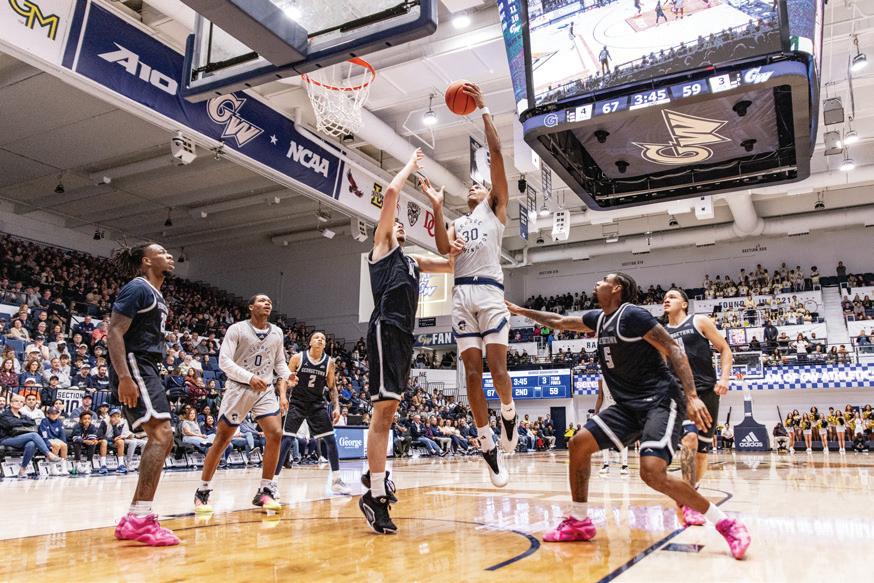
Caputo, who oversaw Castro’s rise last season, said the 6-foot-11-inch forward has the ability to reach that level of play this season for the Revs, which includes him continuing to build off his work around the rim.
“If he plays to his potential, certainly he’s got that ability,” Caputo said.
Expectations on the team this season are higher than they have been in years, in part of Castro, whose presence in the front court added another wrinkle into the Revs’ offense. The Revs, who finished 21-13 and 9-9 in A-10 play last season, are projected to finish fourth in the conference after being projected to finish 13th last season.
As a senior and veteran of the team, Castro said the pressure and high expectations from the A-10 on his squad this season will only make them compete harder.
“I tell my guys, pressure makes diamonds,” Castro said. He said the team worked on getting closer
on and off the court over the summer, which will help them continue to gel and perform on the court.
“I think it’s great,” Castro said. “We really focused on connectivity, and I think we’ve done a good job of that on court and off court also.”
In the Revs’ exhibition matchup with Georgetown University on Oct. 18, Castro and his team fought until the end, competing with their power-five conference opponent, a sign of a team ready and able to compete for the top spot in the conference. In the Revs’ 73-64 loss, Castro scored 12 points — the fourth most of all players — and hauled down seven rebounds, the latter of which was a team high.
Ahead of his redshirt senior season, with high expectations for the team and himself, Castro said it would not be a surprise to see this team make a run for tournament success.
“To win the whole A-10 and make a run in March Madness, that’d be great,” Castro said.


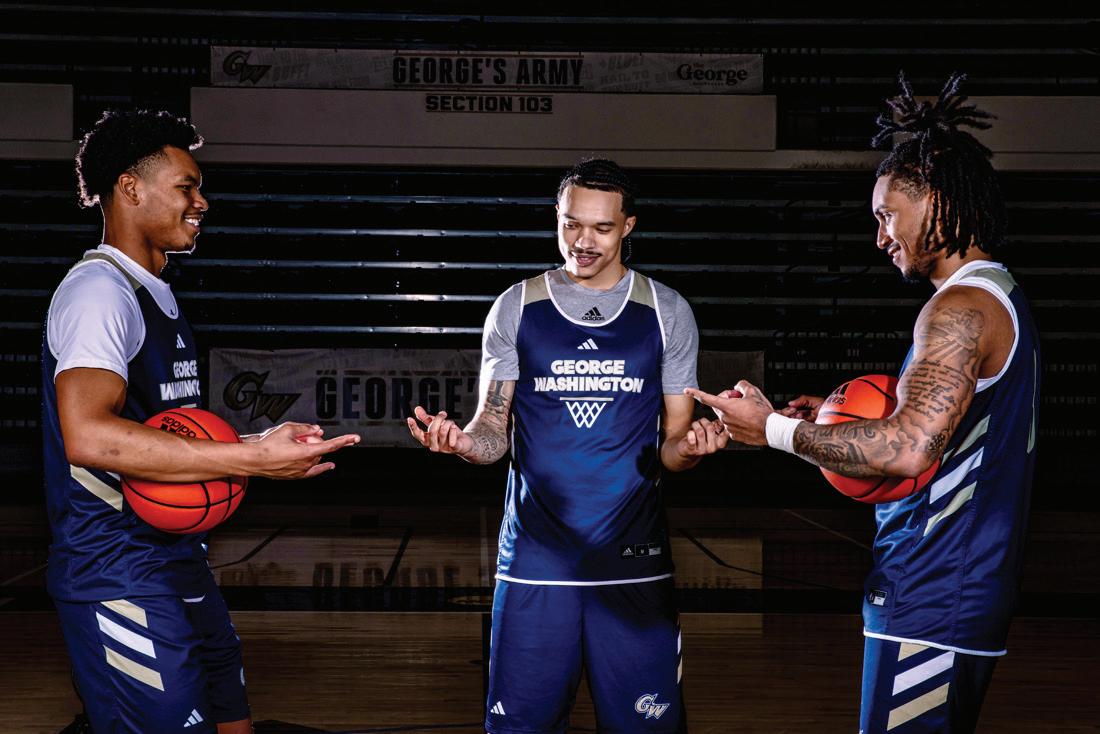
Men’s basketball’s backcourt is stocked with size, shooting capability and Treys. Guards junior Trey Autry, redshirt senior Trey Moss and graduate student Tre Dinkins III share more than just a name — they each bring a unique skill set to this year’s backcourt, contributing on both ends of the floor. With high team expectations and a star big man in forward Rafael Castro, guard play could be the team’s make-or-break at what’s a deep and diverse position for the team.
Last year, Autry was a significant piece to the team, starting 19 of 34 games and averaging 10.4 points per game. Moss, who started 15 games, was a key contributor in the beginning of the year before taking more of a reserved role later in the season due to his declining scoring. While Autry looks to be a dayone starter for the team, Moss is pegged as a bench contributor after losing his starting spot midway through last season.
Dinkins is a new addition to this year’s roster, transferring from Atlantic 10 foe Duquesne this spring, where he averaged 12.9 points per game last year. That stat line last year would’ve made him the Revolutionaries’ highest scorer, behind only Castro. These three, combined with a crowded group that includes redshirt sophomore Christian Jones and junior Jean Aranguren, make up a talented group of pure guards that Head Coach Chris Caputo has at his disposal to deploy.
For a team with a dominant big man in Castro and a solidified forward room with Bubu Benjamin, Tyrone Marshall Jr. and Garrett Johnson, returning after missing last season with a torn ACL, consistent guard play from the trio of Treys — or Tres — is crucial if the Revs are going to make noise in the A-10 this season.
Caputo said the team spent the offseason experimenting with lineup combinations and
Column: Transfers have potential to raise men’s basketball standing
From Page 1
Yet there’s reason to believe this unit will be strong. The backcourt’s combined returning experience of over 200 collegiate games gives GW one of the A-10’s most established guard rooms.
Dinkins brings a veteran presence to the roster as a graduate student transfer from conference competitor Duquesne. With the Dukes, Dinkins averaged 12.9 points per game and achieved Second-Team All-Atlantic 10 honors. A known scorer with conference knowledge fits Head Coach Chris Caputo’s
older, steadier backcourt model — an image different from his 2023-24 team packed with unprepared freshmen. Those freshmen have now matured, including Autry, who is entering his third year at GW after averaging 10.4 points per game and starting in 19 last season. He’s an energy guy who thrives in clutch moments, like the team’s win over Fordham in last year’s A-10 tournament, in which Autry drained three straight 3-pointers to seal the victory. If he can find sparks like this more consistently, he can be a real offensive weapon for the Revs. Jones, heading into this sea-
son with a preseason ThirdTeam All-Conference nod, worked on shooting off the dribble and left-handed drives this offseason. He could break out even more if he adds decisionmaking consistency on offense. Leading the team last year in both steals and turnovers, honing in on his defensive aggressiveness while cleaning up mistakes would shape him into an elite player.
Make-or-break transfers
The bigger question marks, of course, come from the team’s transfer crops. Forward Luke Hunger, a 6-foot-10-inch Northwestern transfer, is athletic for
his size and can play by Castro’s side but would most wisely be the star’s backup, given the lack of other big men on the roster. Graduate student forward Tyrone Marshall Jr.’s addition will add some versatility to the lineup, with a unique blend of size, athleticism and shooting skills. Coming from Western Kentucky University, the 6-foot-8-inch forward shot 37.2 percent from beyond the arc in 2023-24 before shooting 31.5 percent the next year. While he doesn’t need to match Johnson’s efficiency as a relief agent, another weapon from deep will add to the Revs’ ability to space the floor.
integrating the new talent and thinks of his roster with different “pods” of players, including Castro and graduate student forward Luke Hunger as the team’s big men and a group that he describes as the “big wings,” including Johnson and Benjamin.
“You got the Trey, Trey, Tre, Christian and Jean in the backcourt,” Caputo said. “ Autry, entering his third year with the team, is the only player to have been on the court that long without interruption. That experience has him thinking seriously about his role as a leader, prompting him to take on a more intentional mentorship role for the younger players.
“I’m still that fun guy,” Autry said. “But now that you’re a vet, you’ve got to be more serious, help the newer guys out, older or younger, because at the end of the day, we’ve all got the same agenda.” Moss, a redshirt senior who previously played at the University of South Florida and the College of William and Mary, is entering his second season with the Revs, following a year in which he started 15 games and played in 29. Moss said he feels more confident entering his second season in the Atlantic 10 after having one year at GW under his belt.
“Being in it for a season, you get to see what it contains, players, different coaches, different play styles,” Moss said. “So to be able to see that, you feel established.”
Before joining Duquesne, Dinkins played at Harcum College from 2020 to 2022 and Canisius University from 2022 to 2024. Of this year’s squad, the former Duke noted that the team has all the pieces of a winning team — they just need to come together on the court.
“We’ve got all the pieces,” Dinkins said. “We’ve got the ability to guard, the ability to shoot, drive, pass, things like that. I think we gel together well and complement each other’s games.”
With the addition of Dinkins this season, Autry and Moss said the nicknames that used to differentiate them have morphed. They said they used to share the epithet “two-time” but that Dinkins’ arrival sailed its departure.
Beyond this, there’s Jean Aranguren and Bubu Benjamin, who can both come in as wing scorers with size and shooting ability. While their usage in Caputo’s rotation remains to be seen, they both have upside after succeeding at schools in less competitive conferences.
The beauty of this roster is in its depth in the backcourt, and the star power of Castro in its frontcourt. This squad is a new kind of dynamic and diverse — a lineup we have yet to see in the Caputo era. If guards can click, forwards perform and Johnson stays healthy, this team could be in conversations come March. I expect they will.

BASKETBALL GUIDE 2025
Sophomore women’s basketball sensation hungry to lead team to victory
Every shot Gabby Reynolds takes is driven by one thought: never let losing feel normal.
Following a breakout rookie season that earned her Atlantic 10 All-Rookie honors, Reynolds returns to Foggy Bottom this season eager to elevate women’s basketball to the next level. After she picked up a spot on the A-10 Preseason All-Conference Second Team this fall, the sophomore guard said she’s determined to help steer the Revolutionaries into a new era — one defined by resilience and redemption after last year’s challenging season.
“I am striving to be First Team All-Conference,” Reynolds said. Reynolds’ first season was one of promise and persistence. She averaged 10.5 points per game, scored in double figures 14 times and was third among all A-10 first-years in conference scoring averaging 11.3 points per game. Reynolds set the tone for her college career right out of the gate, scoring 17 points and dishing out three assists against University of Delaware in her collegiate debut, a performance that earned her A-10 Rookie of the Week honors last November.
Despite Reynolds’ standout individual performance, the Revs struggled as a team last season, eventually going 13-18 and 5-13 in the conference. Former Head Coach Caroline McCombs, who recruited Reynolds, also stepped down just weeks before the end of the sea-
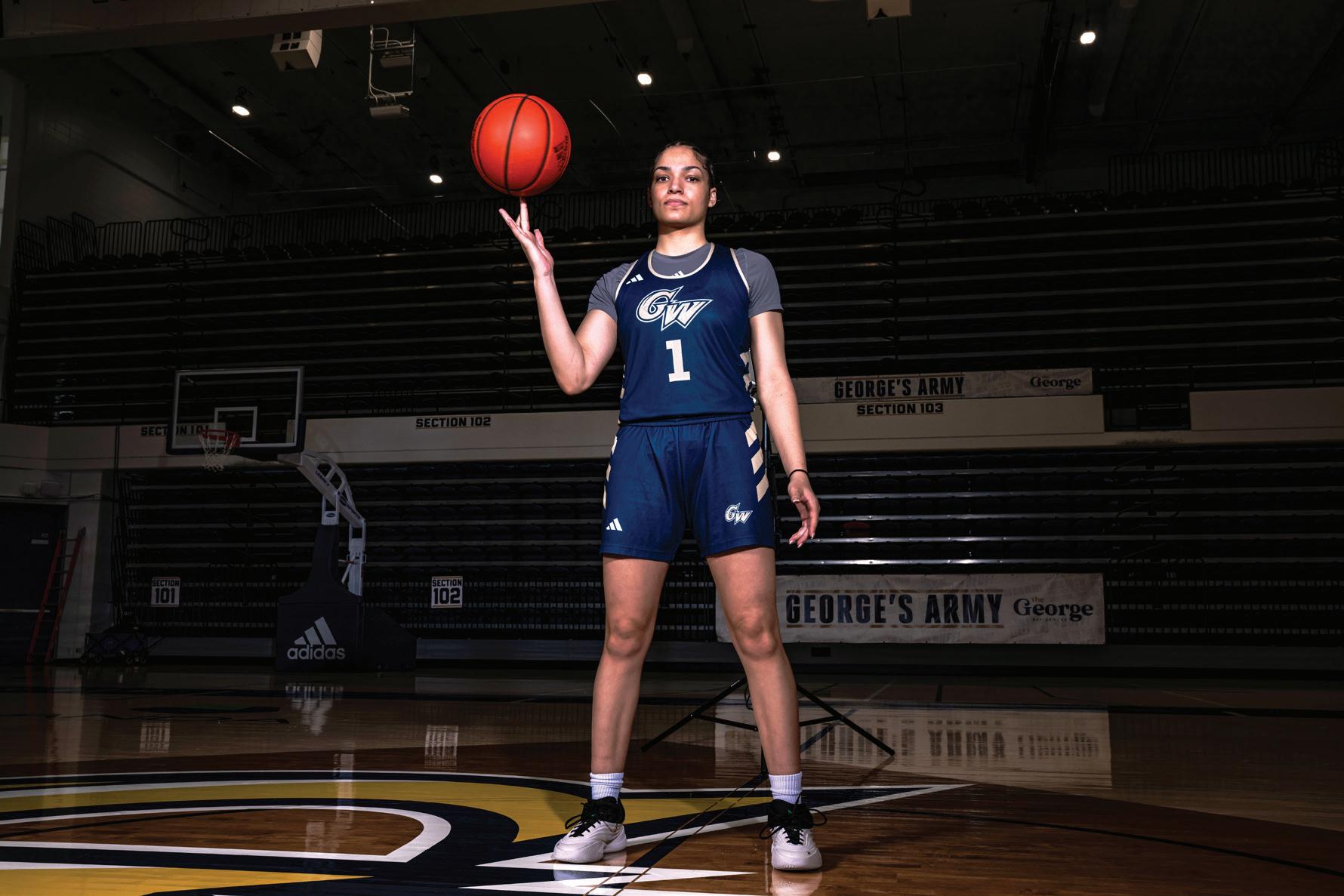
son, leaving the team in search for a leader to return the team to relevancy.
She said the team’s new head coach, Ganiyat Adeduntan — who GW Athletics hired in March — has improved the team’s culture by leading more focused practices, helping them play more fluidly and fostering stronger connections on and off the court.
“She’s made a huge impact on the team,” Reynolds said.
Channeling her determination to win, Reynolds pours her energy into mastering the little things — whether its getting shots up late at night or sharpening her fundamentals — and honing in on those details to fuel her performance when the pressure is on. She also said she’s been focusing specifically on expanding her offensive repertoire this offseason, growing her comfort zones on the court to beyond the 3-point arc.
‘Coach G’ trusts the process as she takes reins of women’s basketball
Women’s basketball
Head Coach Ganiyat Adeduntan knows the sport isn’t life and death.
Between her years playing college basketball at Florida State University and beginning her coaching career, Adeduntan worked as a nurse practitioner — an experience she said helped her learn to see the bigger picture. Since returning to basketball full-time in 2014, she’s carried those lessons with her, approaching her players holistically and prioritizing them as people first.
“When I think about coaching our players, I think teaching and educating is the best part of what we do,” Adeduntan said. “We also have to be able to see them, not just as basketball players but as human beings, as people.”
Hired by GW Athletics in April after four years as
the head coach at Colgate University, Adeduntan — known around campus as “Coach G” — said she’s spent significant time connecting with players, both new and experienced. She said she’s prioritized building a unified culture within her program, building a team that plays hard and feels “connected” to each other.
While she’s had to adjust to a new group of players, acclimating to Foggy Bottom hasn’t been difficult for Adeduntan. She’s been here before — serving as an assistant coach from 2017 to 2022. Now back in D.C. as the program’s leader, she said she feels incredibly grateful for the privilege to guide the team and help shape its future.
“This level of gratitude fills me constantly,” Adeduntan said.
Adeduntan’s first year as an assistant coach at GW saw the Revolutionaries capture an Atlantic 10 title and secure an NCAA Tournament appearance
that year, the team’s most recent trip to March Madness. After four seasons, she left to take the top position at Colgate, where she steadily improved the team’s record each year, establishing a culture of growth and success as their head coach.
Since returning to GW, team culture and identity have been at the helm of Adeduntan’s vision as she builds her program from the ground up.
In Adeduntan’s view, building a strong team culture is the first step toward returning the program to its championshipcaliber standards.
While she understands returning to this level of play immediately is unrealistic after nearly a decade of subpar play, she believes it is in the cards eventually. While the team works toward that vision, Adeduntan said she is looking to see consistent small improvements.
“We understand that we have a lot of work to do,” Adeduntan said.

Last season, Reynolds shot 28.2 percent from beyond the arc. She attempted the most 3-pointers on the team last season and fell just above the team average of 27.1 percent.
“I think last year I could have shot a lot better.” Reynolds said. Reynolds pointed to specific areas where the team has improved heading into the new season, including in implementing new defensive schemes and playing more cohesively as a team. She said their
refined defense is going to make a large impact on their play, helping to force turnovers and create pressure on opposing offenses.
“If we can get stops and be very aggressive and intimidate whoever we’re playing against with our defense, I think that’s going to be a huge mark for us, and it’s also going to help our offense.” Reynolds said.
Reynolds said the team buying into the coaching staff’s vision will be vital to its success in the season ahead. She said Adeduntan is particularly intentional with her emphasis on cohesion and team chemistry.
After last season’s frequent losses, Reynolds said it was mentally “challenging” to learn how to bounce back each time. It was the first time she had been on a team that experienced consistent losses, but she said she learned to approach each game with the same mindset — focusing on performing her best and controlling what she could to help the team succeed.
While the A-10 preseason poll picked the Revs 10th — two spots higher than last year’s poll — Reynolds said the team is motivated to prove doubters wrong. She said her teammates have been instrumental in building the program’s new culture by bringing a new energy to the court, adding that she is optimistic about the program’s trajectory.
“I just want to make it a turnaround year for us,” Reynolds said. “I think last year we didn’t fulfill the expectations that we had for ourselves, so this year is a new year for us to make changes that need to be made.”
Column: Adeduntan can be the guiding light women’s basketball needs
Head Coach Ganiyat “Coach G” Adeduntan’s hiring marks a reset for women’s basketball.
Entering her first full season as head coach, Adeduntan has taken the reins of a program that finished 13-18, 5-13 in the Atlantic 10 last season and endured an eight-game losing streak before former head coach Caroline McCombs stepped down mid season. Between a culture revamp, staffing alterations and her overall coaching IQ, Adeduntan has already started trying to alleviate the dysfunction she inherited in March — a necessary and important step. Still, even as she addresses immediate issues, maintaining a longterm vision will be crucial to sustained success.
Adeduntan has the resume to prove she can pull off such a turnaround. Before returning to Foggy Bottom, she led a Colgate University team that saw two 20-win campaigns and the program’s first back-toback WNIT appearance, also overseeing a 17-win improvement over her first two seasons with the Raiders. The team’s record did a dizzying 180, moving from 6-24 to 23-9 between 2021 and 2023. It takes coaches years to build out programs, add talent and achieve winning records, and Adeduntan did it unbelievably quickly with the Raiders.
Still, it’s not just her record at Colgate that stands out — it’s how quickly and decisively she turned a struggling program into a contender, a model for the rest of women’s basketball to follow. Now, GW needs Adeduntan to bring that same success to its own program.
But the question looms: Is it replicable at GW? Her
rebuilding approach will be tested in a higher-pressure A-10 conference. I hope her methods are effective in this new environment and are not drowned out in a more competitive league, and I think it’s possible if she remains committed to culture and balances it with aggressive recruiting to find talented players.
After beginning in March, Adeduntan took the important step of overhauling the team’s staff, scooping Assistant Coach Brianna Finch from Boston University who brings her 18 years of offensive strategy and consecutive 20-win seasons to GW — expertise the Revs desperately need after the team ranked 11th out of 15 in the A-10 offensively last season. Adeduntan is obviously aware of this struggle, also recruiting Assistant Coaches Macey Hollenshead and Lauren Coleman from her staff at Colgate to maintain some leadership continuity.
The roster needs remodeling, too. Adeduntan must build more cohesive rotations and fit pieces of her roster together strategically, which will help the players gel together. McCombs had a pattern of implementing constantly changing lineups and seemingly randomized playing time that caused discombobulation on the court, which was a big reason the team struggled down the stretch.
With new players and a new system, returning sophomore Gabby Reynolds and junior Sara Lewis will be strong pieces that Adeduntan must build around. Reynolds boasts A-10 All-Rookie honors as a consistent offensive and defensive contributor for the Revs. She scored in double figures 14 times during her rookie season, including 12 times in A-10 play, making her second on the team in
scoring last season, averaging 10.5 points per game. Lewis’ experience and stats will boost the team, given she averaged 5.5 boards per game last season while shooting from a .330 clip. While not extraordinary, Lewis’ consistency doesn’t harm the team and is needed to stabilize the roster.
As a part of her work on the roster, Adeduntan brought in graduate guard Nya Morris from Claflin University, a 43.8 percent shooter from behind the arc, which should help address GW’s 27.1 percent team 3-point average that lands them 12th in the A-10. On the court, Adeduntan’s style is centered on holistic development: emotional wellness, academic success and personal accountability as pillars of her leadership. While I appreciate the focus on culture, in today’s money-driven NCAA, it only goes so far in recruiting and retaining talented players. I worry about this culture-first approach and fear it isn’t enough to immunize GW against the transactional, name-image-likeness-driven team building in the NCAA. While fostering a better culture and promoting overall well-being is optimal for a healthy program, this alone will not pin down success-hungry players in the current college basketball environment.
Adeduntan’s trend of upward mobility, empathy-driven leadership and understanding of institutional goals is a foundation for long-term progress. But she must prove she can restore the program’s success and spirit and do so quickly, given how the past few years have looked. The coming season will determine whether GW’s next era begins with Adeduntan.

Faculty Senate Executive Committee elects temporary co-chairs
GIANNA
The Faculty Senate Executive Committee elected two interim co-chairs on Friday, following the chair’s resignation late last month after some committee members requested that she step down.
FSEC elected Guillermo Orti and Amita Vyas as temporary co-chairs following the resignation of former Chair Katrin Schultheiss last month, after six of nine representatives requested she step down over unspecified concerns, with the senate electing a permanent chair at the Faculty Senate’s Nov. 14 meeting.
Two additional FSEC representatives — Sameh Badie and Jeffrey Akman — are no longer listed as committee members on the senate’s website after last month’s meeting, which triggered a heated debate over the committee’s request for Schultheiss to resign.
The Faculty Organization Plan stipulates FSEC can elect a replacement chair or voting representative in the event they are unable to serve temporarily or indefinitely until the
next regular Faculty Senate meeting, where the senate will elect a replacement for the remainder of the FSEC term. The plan does not detail the exact election procedure.
Schultheiss stepped down from her role helming FSEC sometime before the Faculty Senate’s October meeting, in lieu of the committee’s alleged threat to hold a vote of no confidence.
The three FSEC members who opposed calls for Schultheiss’ resignation criticized the other members’ request, prompting Faculty Senator Jamie Cohen-Cole to propose a resolution to remove all FSEC members from their positions, which never reached a vote after the meeting lost quorum.
FSEC temporarily elected Orti to replace Schultheiss as the Columbian College of Arts & Sciences FSEC representative, Vyas, the Milken Institute School of Public Health FSEC representative, was one of the six members who called on Schultheiss to resign. Orti declined to comment on the changes within FSEC. Vyas did not return a request for comment.
Badie, the School of Engineering & Applied Science FSEC representative and one of the six who called on Schultheiss to resign, and Akman, the School of Medicine & Health Sciences FSEC representative — who sparked the initial conversation about Schultheiss’ resignation and opposed the six members’ calls for her to step down — are no longer listed as FSEC committee members on the website.
Badie and Akman did not return a request to comment on why they are no longer listed as members of FSEC.
FSEC temporarily elected Tarek El-Ghazawi to serve as SEAS’ FSEC representative and David Mendelowitz to serve as SMHS’ representative. El-Ghazawi and Mendelowitz did not return a request to comment on being elected as temporary FSEC representatives.
The Faculty Senate will formally elect replacement FSEC representatives for CCAS, SEAS and SMHS to serve for the remainder of the FSEC term at the body’s Nov. 14 meeting, as stipulated in the Faculty Organization Plan.
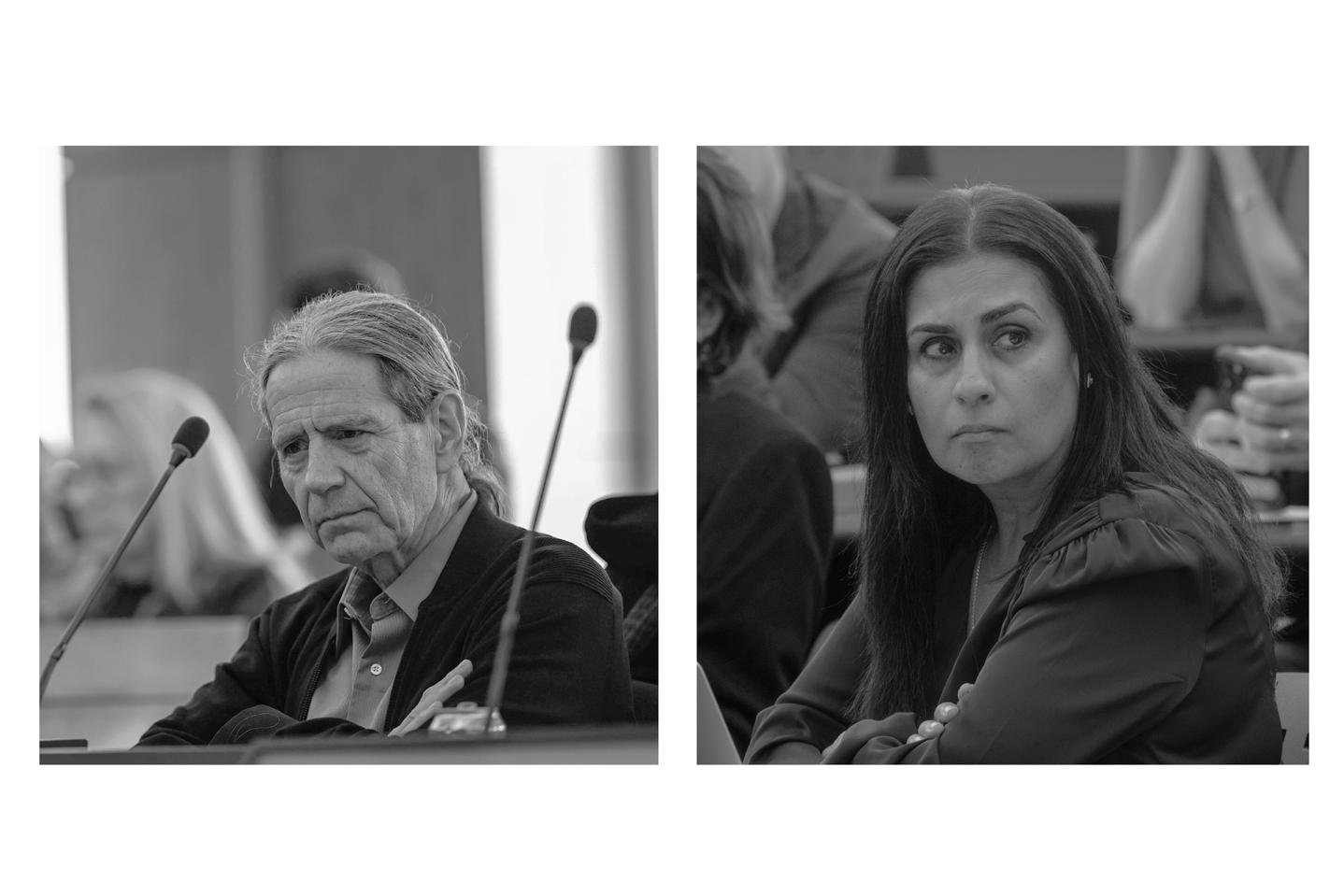
Trump policies sped up GW’s budget cuts despite stable outlook: experts
GIANNA JAKUBOWSKI ASSISTANT NEWS EDITOR
GW ran a budget deficit in fiscal year 2025 for the first time since FY2020 after years of expenses rising faster than revenue, though faculty and experts say President Donald Trump’s policies, not the long-term spending trend, likely triggered cuts.
The University’s expenses outpaced revenue in FY2025 by $22 million, following several years of a narrowing gap between revenue and expenses since FY2022, which experts in higher education said GW could have weathered for five to 10 years before the spending hurt its financial stability. Experts said the University’s financial position remains stable, and officials could have held off on implementing immediate cuts to combat its $24 million budget deficit as of July but were likely compelled to proceed in response to Trump’s policies, which have already begun impacting the University’s finances.
Chief Financial Officer Bruno Fernandes in July said the University has been working to address the structural deficit dating back to at least FY2022, but recent “macro-headwinds” caused officials to accelerate the process, like uncertain international student enrollment due to travel bans and visa processing policies.
“The difference is that we probably would have taken three years to start to address this,” Fernandes said in a July interview. “Unfortunately, we just don’t have that time, and so that’s why we’re accelerating some of these measures.”
University spokesperson Shannon McClendon said many factors contribute to the University’s structural deficit, including market pressures, students’ rising need for financial aid, inflation and
UHS to create non-profit physician group pending finalized deal with GW over MFA
GIANNA JAKUBOWSKI
ASSISTANT NEWS EDITOR
Universal Health Services will establish a new non-profit physician practice group to directly hire Medical Faculty Associates employees if ongoing negotiations to end the University’s financial support for the medical enterprise succeed.
Officials on Thursday said UHS’ physician practice affiliate will directly hire a “significant number” of MFA physicians, clinicians and staff through a new not-for-profit physician practice group that will serve GW Hospital, Cedar Hill Regional Medical Center and other outpatient sites. GW’s release states officials still need to address several issues in the next stage of negotiations, including a shared approach to the MFA’s governance, leadership and operations, as well as staffing levels of physicians, clinicians and administrative employees.
GW reached a preliminary agreement last month with UHS — the owner and operator of GW Hospital — to co-fund the MFA, a nonprofit network of health care providers and School of Medicine & Health Sciences faculty that serves GW Hospital and Cedar Hill. Both parties are continuing negotiations to end the University’s financial support for the medical enterprise, which stood at $444 million to GW and other lenders at the end of fiscal year 2025, with GW loaning it $98 million last fiscal year.
“While no final decisions have been made, meetings are taking place this week and next week with department chairs and leaders to solicit input and consultation on the process and future structure,” the release states.
UHS has created preliminary staffing plans, which officials are currently discussing with department chairs and leaders from the MFA and SMHS, according to the release. UHS will also create clinical and administrative staffing plans for clinical operations, which will also be discussed with depart-

ment chairs and MFA and SMHS leaders, though the release did not specify when they will complete these plans.
As part of the process, the release states GW and SMHS will analyze UHS’ staffing plans for hiring a “significant number” of MFA employees to ensure they align with UHS’ commitment to meeting SMHS’ academic needs.
The initial deal stipulated that GW will continue to fund the MFA’s clinical education under the preliminary agreement, as the enterprise’s physicians teach SMHS’ students, residents and researchers. Bill Elliott, the MFA’s chief executive officer, said last month the framework the parties are negotiating will permit UHS to directly employ clinical and non-clinical staff and faculty, who would remain faculty members at GW.
The ongoing negotiations also come as GW faces a $24 million budget deficit as of July and has undergone University-wide budget cuts to bring the University back to financial stability. Officials acknowledged in late April, in their initial announcement of budget

economic uncertainty. She said officials’ work to address GW’s FY2026 budget deficit is “well underway” and progressing, with GW ahead of projections on spending reductions and revenue in line with expectations.
“In response, the university continues taking strategic, prudent measures to navigate both external challenges and GW’s specific financial issues to build financial resilience while remaining as transparent as possible,”McClendon said in an email.
Officials first announced in late April their plan to slash the University’s expense budget by 3 percent for FY2026 to combat “difficult and immediate budget challenges” and higher education headwinds. Officials said in the announcement that the cuts would address a structural deficit after GW’s expenses surpassed revenue in recent years, which created a “significant and unsustainable gap” that compounded annually.
In July, officials announced additional measures to combat its structural deficit — including a hiring freeze and likely laying off staff and faculty. GW laid off 43 staff members on Sept. 30, with cuts spanning at least five schools and divisions and terminated the hiring freeze on Oct. 13 to revert
to a position review process.
Joseph Cordes, co-chair of the Faculty Senate’s Fiscal Planning and Budgeting Committee, said the Board of Trustees wants the University to end each fiscal year with a small surplus so they have resources to reinvest in the University’s growth. He said officials want to go beyond breaking even every year in the event that officials spend more in the fiscal year than what they had budgeted for, causing them to run a deficit.
The University ended FY2022 with a $24 million surplus, which decreased to a $12 million surplus in FY2023. GW’s surplus rose in FY2024 to $18 million before reducing to a $22 million budget deficit in FY2025.
Cordes said Trump’s administration ultimately triggered the current changes the University is undergoing to combat its structural deficit because officials didn’t expect him to win re-election, which could have slowed officials’ response. He added the University is in a “solid” financial position to respond to the challenges it faces and recover from its deficit.
“The good news here is that I think the University is on top of the challenges and is taking steps now to figure out how to address them, but it will take time,” Cordes said.
CRIME LOG
ROBBERY PICK POCKET, SIMPLE ASSAULT
800 Block of 22nd Street Northwest 10/29/2025 – 7:45 p.m.
Open Case
The GW Police Department and Metropolitan Police Department responded to a female student who reported two male suspects robbed them of their AirPods. Referred to MPD.
CREDIT CARD FRAUD, THEFT II/FROM MOTOR VEHICLE
2100 Block of G Street Northwest 10/27/2025 – 10 p.m.
Open Case
A male student reported unauthorized charges on their credit card after leaving their wallet in an Uber. Referred to MPD.
cuts, that the MFA has contributed to GW’s financial losses.
The acknowledgment came as Moody’s Investors Service and S&P Global Ratings, in reports released in May and August, respectively, affirmed GW’s strong credit rating but revised the University’s outlook from stable to negative, signaling concern that the University’s score could decline if officials fail to end GW’s financial support for the debt-ridden medical enterprise.
Officials have pledged for years to bring the MFA back to profitability but have faced mounting pressure and skepticism from the Faculty Senate as the medical enterprise continued to flounder tens of millions of dollars each year.
“The university, SMHS, the MFA and UHS are seeking to identify the best path forward – one that supports MFA physicians, clinicians, and staff, and also maintains the excellence of the SMHS teaching and research while meeting the clinical needs of the hospital and community,” the statement reads.
UNLAWFUL ENTRY
University Student Center
10/28/2025 – 12:29 a.m.
Closed Case GWPD responded to a report of a female non-GW affiliate who refused to leave University property. Officers issued the person a bar notice and escorted them off campus. Case closed. Subject barred.
MISDEMEANOR SEXUAL ABUSE
2206 F St. NW 10/25/2025 – 7:39 p.m.
Open Case
A male non-GW affiliate reported being inappropriately touched by an unknown male while attending a party. Referred to MPD.
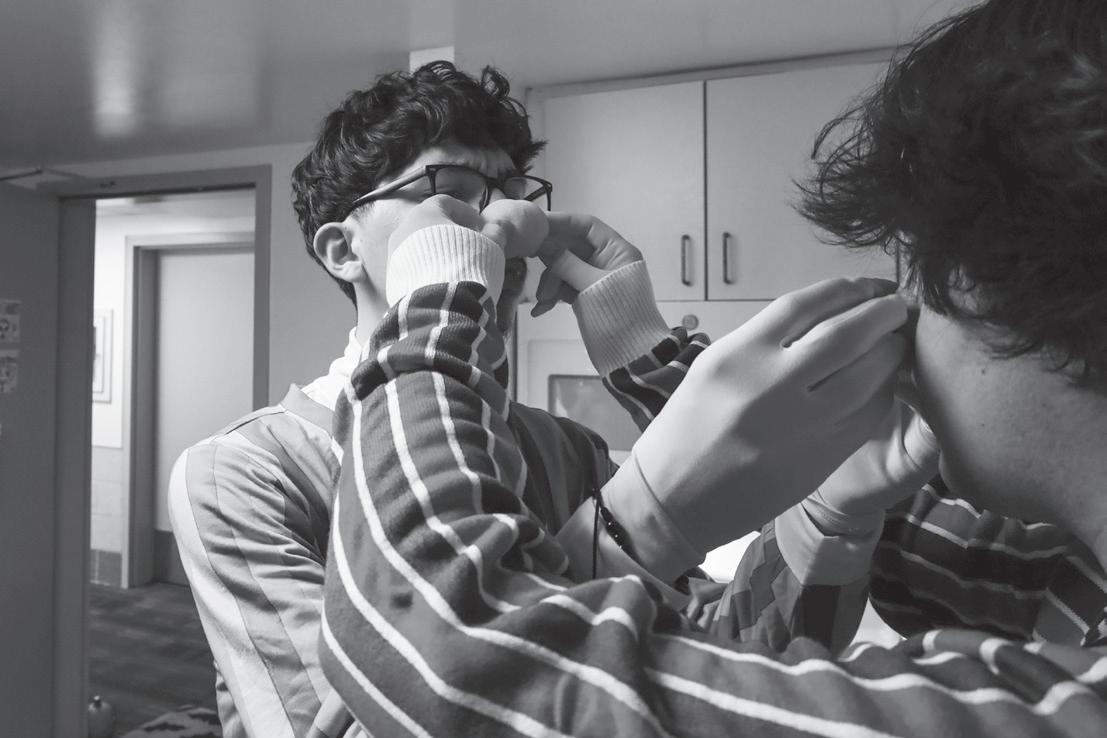

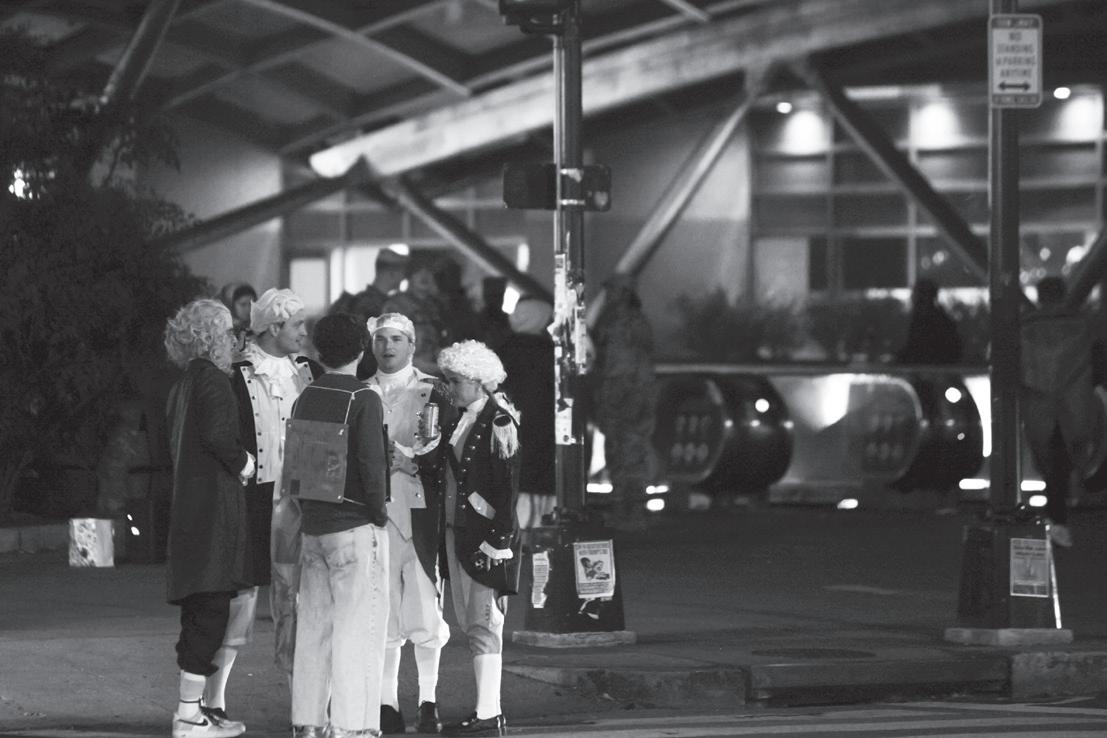
GW researchers launch tracker revealing lack of Medicaid access in rural areas
ABIGAIL ROSEN REPORTER
ARUNMOY DAS REPORTER
GW researchers launched an online tracker last month highlighting disparities in Medicaid access across rural and urban populations that experts say lead to fewer primary care visits and preventable hospitalizations in ru
ral areas.
Researchers at GW’s Mullan Institute for Health Workforce Equity developed the tracker, which allows users to view how many health care providers accepted Medicaid at a county level from 2016 to 2021. Anushree Vichare — co-creator of the tracker and an associate professor at the Milken Institute School of Public Health — said the tracker’s data revealed that rural counties had fewer Medicaidparticipating primary care providers, despite studies showing more people in rural areas use Medicaid, a discrepancy in care that experts said could lead to increased hospitalizations.
Vichare said the tracker revealed that rural areas face a lack of providers accepting Medicaid, an overreliance on nurse practitioners and fewer medical specialists, which experts in health care policy said could lead to more preventable hospitalizations and misdiagnoses.
“It’s like a double sort of edge sword because even though they have Medicaid coverage, right, the coverage may not always guarantee access to primary care providers due to a lot of these structural barriers,” Vichare said.
Medicaid is a federal and state medical insurance program that helps cover health care costs for certain low-income people, the elderly and people with disabilities, with rules around eligibility depending on the state. The Kaiser Family Foundation reported in June that 24 percent of people living in rural areas use Medicaid, compared to 21 percent in urban areas.
Rural counties had significantly fewer Medicaid-participating providers — or providers that accepted Medicaid as compensation for
GW switched security companies ahead of residence hall hours cuts
JENNA LEE SENIOR NEWS EDITOR
Officials changed GW’s security guard company late last academic year after its contract with the supplier they had used since at least 2021 expired, a University spokesperson confirmed.
University Spokesperson Claire Sabin said GW retained Securitas to patrol campus buildings in D.C. and Security Assistance Management at the Virginia Science and Technology Campus in May after officials began soliciting proposals from security contractors last fall, ahead of Allied Universal Security’s contract expiring in the spring. Sabin said the change in security contractors was standard practice and unrelated to ongoing University budget cuts but declined to say if the switch in contractors caused officials to cut back on security hours in certain residence halls this academic year.
“This was a standard business practice and decision to complete the contract, aimed at maintaining the safety of our campus and university operations and is not related to the FY26 budget planning process or residence hall staffing,” Sabin said in an email.
GW formerly contracted Allied Universal Security to assign security officers to residence halls, former GW Police Department Chief James Tate said in 2021.
Officials cut around-the-clock security guard hours in most upperclassmen residence halls this academic year, reducing coverage to the overnight period from 10 p.m. to 6 a.m. Officials attributed the change in August to the
“geographic location” of each building and crime reporting data from the Campus Safety office. The switch comes as the University faces a changing security environment amid increased federal law enforcement presence in D.C. Sabin said officials are aware that community members have “concerns” about federal law enforcement in the District. Students last month reported a “sinister” hike in National Guard presence on campus.
Student employees also reported in February that front desk supervisors circulated a checklist to front desk staff across campus to prepare for potential unannounced visits from immigration enforcement. Sabin declined to comment on whether front desk security personnel have received updated guidance on how to navigate federal law enforcement presence since August, when President Donald Trump ordered federal troops to patrol the city.
University President Ellen Granberg in a community message last month said staff with “public-facing” positions have received guidance on how to ensure community safety if federal law enforcement tries to access a locked facility. A University spokesperson also said in the event of an unannounced visit to campus by immigration enforcement, guidance is available to the community.
“We remain committed to providing a safe environment for our students, faculty, and staff through the efforts of the GW Police Department and coordination with external law enforcement agencies, while ensuring full compliance with legal requirements,” Sabin said in an email.


their services — per 100,000 people enrolled, compared to urban counties from 2016 to 2021, according to the tracker.
The researchers found that many states have counties with no Medicaid-participating providers, including in Georgia, where eight out of the state’s 159 counties have no providers that helped 11 or more Medicaid patients in 2021.
The highlighted disparities come as Medicaid faces national funding cuts. The One Big Beautiful Bill Act, which President Donald Trump signed into law in July, constitutes the largest cut in Medicaid history, with a gross reduction of $990 billion over the next 10 years in federal Medicaid spending, according to the non-partisan Congressional Budget Office. The Kaiser Family Foundation estimates these cuts will reduce Medicaid spending in rural areas by $137 billion over 10 years.
Patricia Pittman, a co-creator of the tracker and the director of the Mullan Institute, said researchers and policymakers can use the data to identify local communities most in need of support.
The researchers used data on Medicaid claims from the Transformed Medicaid Statistical Information System between 2016 and 2021. T-MSIS, a resource created by the Centers for Medicare and Medicaid Services, collects Medicaid enrollment data, patient costs and provider participation for research
and policy use.
Pittman said the Medicaid claims data the researchers used shows that the “poorest” people in the country face the greatest disparities in health care access, including reduced access to providers.
She said Medicaid’s lower reimbursement rates — or payments insurance providers use to pay medical practitioners back for their services — act as a deterrent for rural health care providers accepting Medicaid. In 2020, hospitals only received 88 cents on the dollar in Medicaid reimbursements, according to the American Hospital Association.
“We wanted to be able to shine a light on those types of providers and changes over time where we were not seeing availability of providers, with the hope that policies could be designed to address that problem,” Pittman said.
Janice Probst, a professor emeritus from the University of South Carolina’s Arnold School of Public Health, said the tracker is useful because, unlike previous studies that only count the number of health care providers in rural areas, the tracker incorporates the added layer of Medicaid availability. Other studies may make it seem like rural communities have adequate access to care, without addressing that people in these areas cannot afford the care because the providers don’t accept Medicaid, she said.
Employee health insurance costs to rise as GW changes providers
DAVIS LENHARDT
REPORTER
RACHEL LEMOULT
REPORTER
Faculty and staff health insurance contributions will rise as the University changes its health insurance plan administrator at the start of 2026 — a move experts say likely curbed sharper cost increases but may disrupt care for employees whose providers fall out of network.
Officials announced last month that the University will switch its employee health insurance administrator from UnitedHealthcare to Aetna at the start of next year, resulting in a 6.5 percent increase in employee contributions — or about $3 to $61 more per month, depending on coverage level and salary band. Experts in higher education said the increase in contributions in 2026 comes amid nationwide healthcare cost spikes and remains consistent with expected average hike for all employees nationally, meaning officials’ decision to switch providers may have prevented a greater increase under UnitedHealthcare.
About 65 percent of fulltime medical plan participants will see an increase of less than $20 per month under the new plan, per the release.
Officials began using UnitedHealthcare to provide faculty and staff’s medical, dental and vision plans in 2011, but Aetna will administer GW’s medical and dental insurance offerings starting Jan. 1, managing the provider network and customer service and support, per the release. GW’s open enrollment period began Oct. 6 and closed Oct. 24, allowing employees to add or remove eligible dependents to their plan.
A University spokesperson said the cost of GW’s medical plan has increased at “higherthan-normal” levels over the past two years, which reflects higher healthcare cost inflation nationally. They said the 6.5 percent rise in employee contributions at the start of 2026 demonstrates officials’ efforts to limit hikes in program costs and employee contributions
by renegotiating contracts and switching to Aetna while still maintaining plan benefits and high-quality experience.
The spokesperson said dental plan contributions are increasing because of an overall increase in utilization of dental services and rising costs by providers, while the University’s vision plan costs remain the same due to its plan’s claims experience and pricing from UnitedHealthcare remaining stable.
University spokesperson Katelyn Deckelbaum said switching to Aetna will ensure GW’s benefits remain competitive and sustainable in future years. She said officials regularly review benefit programs to ensure they meet faculty and staff needs, and officials’ decision to change its administrator to Aetna followed an extensive and competitive proposal process.
Deckelbaum said officials evaluated each carrier’s network strength, ability to provide high-quality, cost-effective care and commitment to “exceptional” member service during the proposal process, though she did not specify when the process began. She said officials also consulted the Benefits Advisory Committee — a group of staff and faculty reinstated in 2011 shortly after the University’s switch to UnitedHealthcare and tasked with providing officials feedback about benefits — and the final decision reflected feedback collected from faculty and staff through a benefits employee survey.
Deckelbaum said Aetna’s provider network includes the “vast majority” of doctors, hospital and specialists employees currently access through UnitedHealthcare, and there will not be changes to coverage levels or out-of-pocket costs like coinsurance and copays. She said officials will provide individualized support to employees whose current providers are not in Aetna’s network to find available options.
Aetna’s provider network will also offer additional innetwork options while maintaining access to most current providers under UnitedHealthcare, according to the release. Other enhancements as part of
the transition to Aetna include a dedicated customer service line for GW employees, improved digital tools, simplified navigation of services and access to timely communications and care management programs for those with chronic conditions or those in need of preventive care and mental health support.
Officials’ announcement states that the switch to Aetna will also provide employees access to Aetna’s member portal, a dedicated customer service line and a simplified navigation experience.
“GW continues to prioritize employee well-being and cost management, ensuring access to strong, comprehensive health coverage,” Deckelbaum said in an email.
Joseph Cordes, a member of the Benefits Advisory Committee and a professor of public policy and public administration, economics and international affairs, said officials determined Aetna could offer a better package for administering the University’s plan by providing access to different services when employees experience issues and need support. He said the committee will start meeting again in spring 2026 to discuss employees’ experiences and expenses with the plan.
The University’s announcement said the change from UnitedHealthcare to Aetna will mitigate greater increases in employee contributions and maintain the 79 percent of insurance costs the University pays as part of its commitment to cost sharing, with employee contributions making up the other 21 percent, staying consistent with last year’s rate.
Cordes also said UnitedHealthcare generally has a bad reputation, and the Benefits Advisory Committee received complaints about its customer service, which was a factor in the transition. He said he expects Aetna will maintain and improve the level of customer service compared to UnitedHealthcare.
“I do think there was a feeling that maybe Aetna was going to do a somewhat better job of customer service,” Cordes said.
GW College Republicans, Democrats debate Trump policies
SAMANTHA BURCHARD REPORTER
Members of the GW College Democrats and GW College Republicans debated whether President Donald Trump’s administration has lived up to its promises and maintained the public’s trust in the University Student Center on Wednesday.
The two sides debated whether the Trump administration’s economic, immigration and security policies have strengthened the country or undermined its values almost a year after voters elected Trump to his second term. The Washington Union Society at GW — a nonpartisan student-run debate society that follows the British parliamentary format — hosted the event, which filled the student center’s amphitheater and asked students to vote at the end on which side presented the most convincing argument.
The two sides debated declaring “no confidence” in Trump’s administration, a motion modeled after the British parliamentary system used by the Washington Union Society, which typically results in the current government resigning, with speakers from the Democrats arguing in favor and the Republicans arguing against it. After closing statements, 77 percent of attendees voted in favor of declaring no confidence in the administration, 15.7 percent opposed and 6.5
percent abstained, handing the Democrats the win.
Emily-Anne Santiago, the first speaker for College Democrats and the club’s president, said the Trump administration has failed to fulfill its responsibilities to the American people through its health care, immigration and economic policies. She said Trump’s demolition of the White House’s East Wing last month to make room for a new ballroom served as a “literal representation” of the current state of the country.
“We have torn down the good and great of America, and in its place, he’s building a ballroom,” Santiago said. “A glittering ballroom on the outside and chaos and neglect behind the walls.”
Santiago said Trump’s immigration policies prioritize “harsh optics” over effective policy, and Trump’s focus on raids, deportations and detention centers to slow immigration is indicative of “moral bankruptcy.”
Immigration and Customs Enforcement has ramped up deportations since the start of Trump’s second term in January, growing from about 8,800 deportations in December 2024 to about 17,800 in September, according to ICE data. About 46 percent of the over 61,000 migrants currently held in ICE custody have no criminal record or are pending criminal charges, a jump from
December 2024 when about 6 percent of detainees — around 40,000 total at the time — had no criminal record or pending charges.
“They’ve turned compassion into a liability and weaponized fear against families just seeking safety,” Santiago said.
Colin Slechta, a firstyear and College Republicans’ first speaker, said Republicans across the country do not believe Trump’s administration has been “flawless,” but the government has effectively maintained national security and economic strength.
“We do not stand here to argue that every policy is completely justified or every statement made entirely wise, but rather we stand here to argue that the case against this administration does not meet the high threshold to issue a declaration of no confidence,” Slechta said.
He said the Trump administration’s actions targeting illegal immigration, levying tariffs on dozens of countries to encourage domestic manufacturing and creating the Department of Government Efficiency to cut waste in the federal government all signal the success of his administration.
“When we are $38 trillion in debt and our bureaucracy is this bloated, we should focus less on serving DEI and more on our own issues here in the states,” Slechta said.
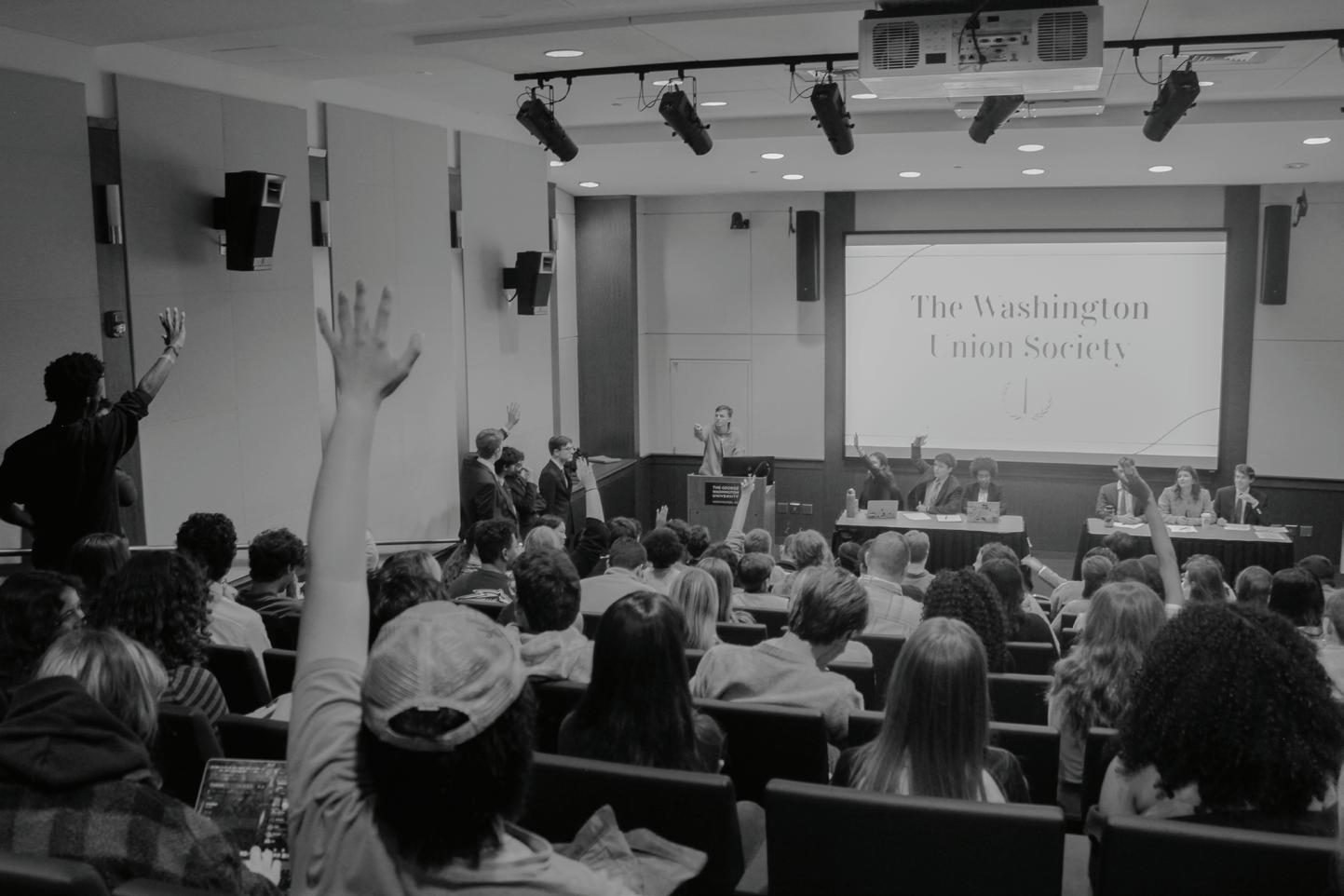
Students form national organization on US-India relations
DIYA JHAWAR REPORTER
SAMUEL PEREZ STAFF WRITER
A GW student founded a national organization focused on U.S.-India relations and launched a chapter at the University this fall, aiming to better understand the political, cultural and economic ties between the two countries.
Senior Aditya Goswamy created the Washington Forum on India in January as a national organization with chapters at four universities, including GW, to create a space focused on U.S.-India economic and political affairs and give students opportunities to engage with leading voices on the relationship, like ambassadors. Students involved in both the GW chapter — dubbed WFI Foggy Bottom — and the national organization said the forum offers pro-bono research and consulting opportunities to Indian companies and professional development through speaker events and networking.
Goswamy, who is majoring in international affairs and serves as the founder and CEO of the national WFI organization, said he brought WFI to its inaugural four schools — GW, Brown, Harvard and Georgetown universities — after reaching out to students he knew at the respective institutions about starting a chapter on their campus. He said WFI is a completely new organization that started this year, adding that three of its four chapters are officially registered at their universities — except at GW due to the freeze on student organization approvals.
Goswamy said he was inspired to start WFI after taking a leave of absence during his sophomore year in fall 2023 to work for the Election Commission of India in India, where he noticed Indian college students of “disadvantaged backgrounds” had an interest in international affairs but didn’t have the resources to explore it. He said he believed that the same passion in international affairs existed at universities like GW and want-
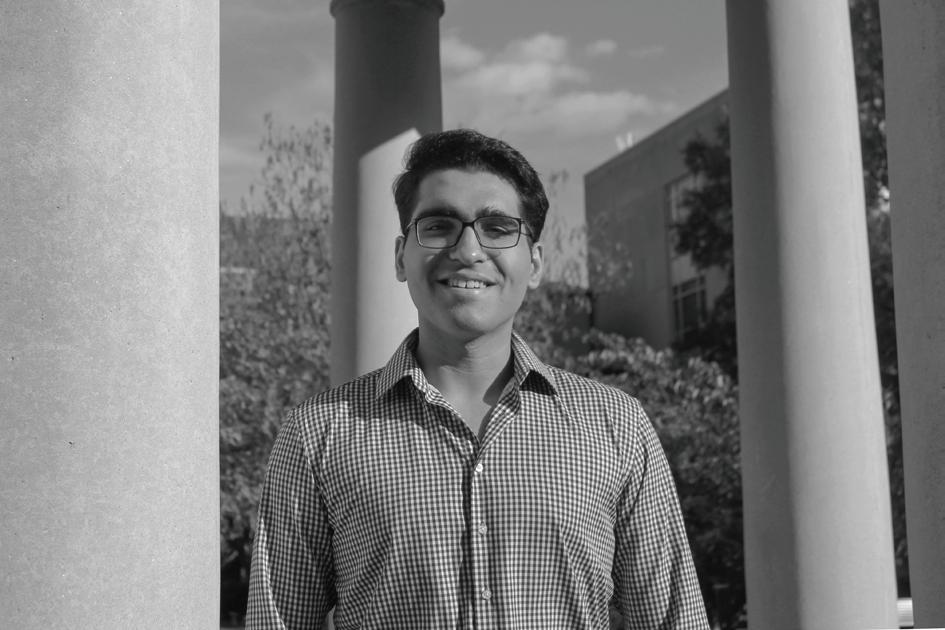
ed to build an organization that would help tie together international affairs and India specifically to American institutions of higher education. He added that being in D.C., especially, could allow for partnerships with people and organizations directly involved in U.S.India affairs, like holding events with think tanks.
“The fact that there was so much passion coming in from inside the country was an indicator that I need to explore this further,” Goswamy said.
Goswamy said students in WFI do pro-bono consulting for Indian start-up businesses, like Shingora Textiles Limited, informing these businesses about the market, regulatory landscapes and political and policy risks of trade between the two nations. He said this allows students to get professional experience in the private sector of U.S.India relations.
“It’s an honor for us to help these businesses figure out the right strategy, and for them, it’s a matter of convenience that we have these young folks that are willing to put in the time for free,” Goswamy said. He said on the national level, WFI has a governing body of students at different schools that presides over all chapters to ensure each chapter’s research output is frequent and of high quality, while also developing strategies on how to reach companies with their services.
“No one’s getting paid to do this, and so ensuring that people have a set of institutional standards and processes to follow is what we rely on,” Goswamy said. Siddharth Kwatra, a
sophomore majoring in finance and international affairs and the president of WFI Foggy Bottom, said WFI is made up of student teams focused on research, outreach and marketing to obtain clients for WFI’s consulting and to maintain up-to-date information on the state of U.S.-India diplomacy and relations between the two countries to help inform these clients when they make business decisions.
Kwatra said the research work done at WFI Foggy Bottom prepares students for future careers in U.S.-India policy and in other fields, as it covers international geopolitics and financial markets, and the lessons learned from participating in this research can be applied beyond U.S.India relations.
“There is no limit what they can choose,” Kwatra said. “If they want to choose something in AI technology in the U.S.-India corridor, if they want to focus on something like psychological they can. They can do that, anything they want.” Dia Makhecha, a sophomore international student from Mumbai, India and co-director of communications for WFI Foggy Bottom, said she hopes the organization can gain traction by hosting more events throughout the year, which will attract students who are primarily interested in joining the research teams, as well as consistently posting on social media.
“There’s no limit to who we partner with,” Makhecha said. “We want our reach to expand across the university to people that are not international affairs majors.”
I Street Mall renovations improved ambiance, boosted traffic: vendors, students
Almost a year after officials completed construction on the I Street Mall aimed at improving visibility into the area by lowering plants and adding permanent lighting, vendors and customers said the renovations have boosted the area’s atmosphere and encouraged customers to stay longer.
Officials wrapped up renovations on the I Street Mall outside the Foggy Bottom Metro last November and said the work improved pedestrian conditions and reduced the area’s rat population, which vendors at the mall’s weekly farmers market agreed with. Vendors and customers at the farmers market said the area feels cleaner and less crowded without construction fencing, and the rat population in the area has decreased, though some said the market still struggles with crowding.
Vendors last year during construction said the reduced width of the walkway through the market due to construction fencing caused a drop in sales and foot traffic, and students said they noticed people walking quickly through the tightly packed market rather than shopping.
University spokesperson Shannon McClendon said last year’s renovations included lowering plant beds to sidewalk level to improve pedestrian visibility and installation of Xcluder anti-rodent mesh, Bigbelly anti-rat trash cans, additional lighting and increased seating options.
McClendon said officials’ goals for the project included reducing the rat population — which vendors and customers complained of when construction started — and improving pedestrian safety, both of which she said they made progress toward achieving. She said since the renovations wrapped up, officials have received “anecdotal evidence” of a reduction in the rat population from groundskeepers and other staff.
McClendon also said officials have coordinated with FRESHFARM, which operates a weekly farmers market in the mall, since the project’s conception in 2005, and they have not received any requests from community members or vendors for more infrastructure upgrades since construction concluded.
FRESHFARM is the D.C. nonprofit operating farmers markets at the I Street Mall and throughout the District, Maryland and Virginia. Foggy Bottom’s market runs Wednesday from 3 to 7 p.m. for most of the year and 2 to 6 p.m. during the winter.
FRESHFARM Market Operations Manager Evan Paramore said the renovations achieved their main goal of turning the space into a place students could hang out rather than just pass through, especially in the fall and winter when the market is still open after sunset as the day shortens.
“I think the improvement in community space has been really significant,” Paramore said.
He said the permanent lights in the mall have been critical to maintaining foot traffic later in the day, allowing vendors to take advantage of the market’s later hours when traffic used to drop as night fell.
“People are still visiting the market, purchasing products and eating even after dark,” Paramore said. “So it’s really kept that last bit of time pretty busy with crowds when it used to kind of trickle off when it got dark out.”
Paramore said sales at farmers markets across the District have dropped compared to last year, which he said was because of the broader economic malaise throughout the city and country rather than any issue specific to Foggy Bottom, like last year’s renovations. He said rat infestations, also a city-wide issue, have persisted at the market despite the University installing anti-rat trash cans and lining.
Kaydee Hall, who works for Roggenart Bakery, a vendor at the farmers market, said the biggest

shift since officials completed renovations has been a noticeable reduction in rats since crews removed bushes so passersby can access the market from the sidewalk.
“I did notice that there was less rodents and things that were running around,” Hall said.
Hall said the market feels more active now, with people passing through the area being better able to see the vendors’ stalls, which she said has driven up sales for the bakery. Officials swapped dense bushes in the gardens located in the middle of the mall that reached eye level in some areas for low-rising, more sparsely planted flowering shrubs.
She also said more people are spending time in the market, contrasting with last year, when students said people hurried down the narrow pathway without stopping to shop.
“It does seem to be that more people are seeing us,” she said. “It does seem busier this year.”
George Barajas, who manages the Barajas Produce stall at the market, said removing bushes lining the market decreased the number of rats in and around the mall, and increased lighting has attracted more shoppers for longer periods of time.
“There was a huge rodent problem,” Barajas said. “It didn’t look as appealing as it is right now. I feel like it was greatly beneficial for the market.”
Still, he said the rat problem hasn’t been fully resolved, and instead it has moved to other areas, like the bushes lining Ross Hall across the mall from the Metro station, which the renovations did not address. He said officials should extend their construction efforts to rat proof that side as well.
Amina Wague, a student at Howard University who works at D.C. Tutoring and Mentoring’s stall at the market, said the rat infestation has worsened since GW’s renovations. She said efforts to rid the I Street Mall of rats may have displaced rats to a nearby GW GroW community garden.
“I believe that the rat problem was exacerbated,” Wague said. Sophomore Daniel Millan, who shops at the market, said he hasn’t spotted a single rat over his past three visits in the last month but said he still thought the space is too cramped to be comfortable and didn’t allow for FRESHFARM to host more vendors, which he said he would have liked to see.
“It is a little cramped up in the space,” Milan said. “I feel like a lot more vendors could possibly be here if there is, like, a more allotted space for them.”
OPINIONS
The Faculty Senate is wasting its platform
STAFF EDITORIAL
At a moment of mounting uncertainty for GW, the Faculty Senate is underleveraging its platform and access to top officials. The body cannot criticize GW for poor communication when its senators let meetings pass without pressing for updates on critical issues. They cannot accuse the University of violating shared governance while using their time with officials to air internal grievances in public, signaling that they are distracted, disorganized and focused on the wrong priorities. Their behavior at October’s Faculty Senate meeting — notably the first since GW laid off 43 staff and struck an initial deal with Universal Health Services to co-own the debt-ridden Medical Faculty Associates — was immature, and watching them waste that time with top officials was painful.
Stakeholders across the University have long pressed for greater transparency and direct access to GW’s leaders. Many seeking more information on pressing issues — like budget cuts, staff layoffs, GW’s plan to sever financial ties with the MFA and the future of diversity, equity and inclusion initiatives — lack both the access and forum to question officials, a limitation that extends to this editorial board. The Faculty Senate has both, and in recent months, it has misused the platform so many in the community wish they had.
These faculty representatives have a public platform to question the University’s top officials. They can draft resolutions and deliver presentations that have the potential to drive real change. They have immense influence, and right now, they do not appear to be using it.
Ahead of last month’s Faculty Senate meeting, we had already planned to discuss our concerns that senators were underusing their platform — evidenced by failures over the last few months to address
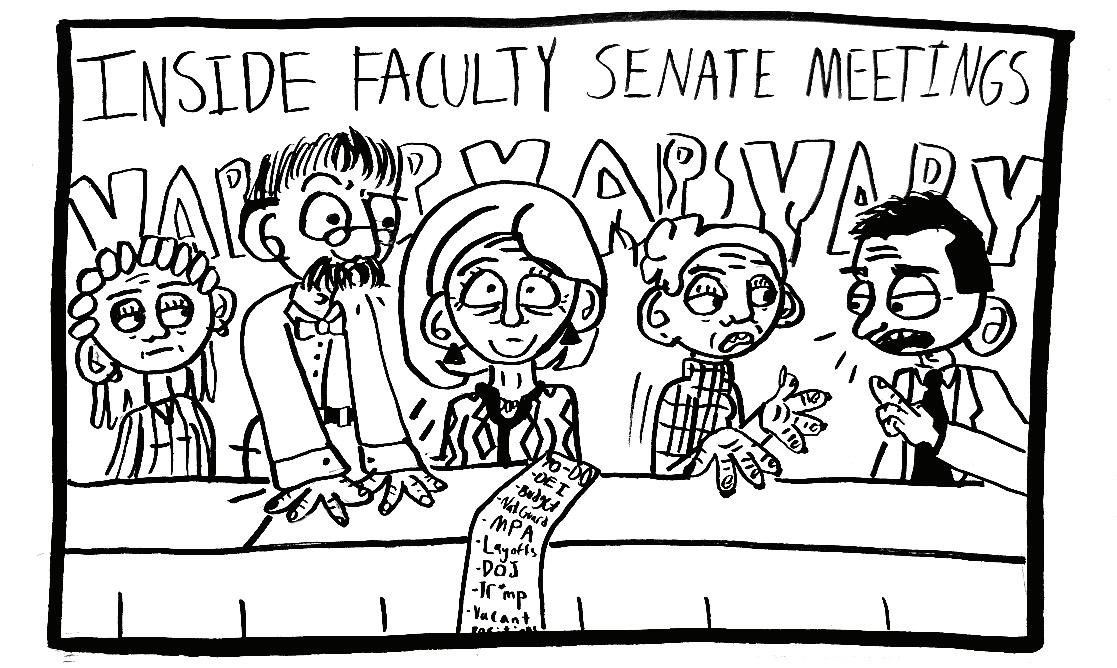
and seek clarity on key issues, even those teased by top officials at meetings. Those concerns only deepened after October’s meeting. At the body’s first public meeting since officials laid off 43 staff members — the first round of University-wide personnel cuts since the COVID-19 pandemic — and disclosed negotiations with UHS over the MFA, faculty senators sat before top administrators, including University President Ellen Granberg and Interim Provost John Lach, and spent their time arguing over issues they refused to specify. The Faculty Senate Executive Committee asked its chair to resign. But with so much uncertainty facing the University and higher education at large, watching senators use their plat-
form this way was disheartening.
The word “layoffs” never came up once during the meeting. Not a single senator asked about the MFA, diversity, Trump, international students, the Department of Justice’s antisemitism findings, financial aid, visas or budget cuts — the conversations that actually matter to the community. Senators ask to be taken seriously by officials and for them to consult the body on major decisions but last month spent their limited public time on infighting instead of tackling any of the countless issues facing the University. We don’t know what led to this situation and don’t have enough information to judge whether asking the chair to step down was justified. But it should not have been handled
Schultheiss championed shared governance. Her successor must too
After years of littleto-no collaboration between the Student Government Association, Staff Council and Faculty Senate, all three groups have maintained open lines of communication as they work together to combat challenges. Much of that progress can be traced directly to the leadership of former Faculty Senate Executive Committee Chair Professor Katrin Schultheiss, whose near-six-month tenure marked the first time in recent memory that such collaboration had truly taken root.
14 senior officials who serve in various capacities and attend their regular public and private meetings. Their voice carries weight in presidential searches, budgetary priorities, strategic planning and even student-centered concerns — decisions that affect the entire University. The effectiveness of the Faculty Senate rests on leadership that takes seriously both its formal powers and its responsibility to the broader University community.
best when every community member has a seat at the table.
Losing a leader who embodied openness and integrity is a loss not just for faculty but for the entire GW community. The principles Schultheiss championed in working with students and staff deserve to be honored within faculty governance as well.
Wthat way in a public meeting.
The Faculty Senate once pressed officials for constant updates on issues like the debt-ridden MFA and demanded shared governance. At September’s meeting, Granberg mentioned that GW was in negotiations with UHS over the medical enterprise, and not a single senator followed up or appeared to notice the disclosure.
The Faculty Senate did not so much as mention the staff layoffs at October’s meeting. Senators notably declined to ask officials for the current figure of the University’s budget deficit — information the community has not received an update on since July. We know The Hatchet’s news team has requested this figure, but without direct ac-
cess to officials, their inquiries are limited to emails. The community deserves transparency. We do not understand why the Faculty Senate, with its access and influence, has not used its platform to publicly ask for that type of information.
As an editorial board, we have spent the past few months asking officials for more information on the 43 staff layoffs, their budgetcutting priorities and ongoing negotiations with UHS over the MFA. We have called on officials to better support staff, to be specific and transparent about the goals of the strategic framework, to center students in decisions about graduate programs and to affirm GW’s commitment to diversity, equity and inclusion. We do not have the platform the Faculty Senate does. We do not have direct access to officials. Our only way to reach them is through our reporting and editorials. We use that platform every week to amplify the community’s concerns and hope officials read what we publish.
During a time of uncertainty and fear, every member and governing body at this University must stand up for the community’s priorities. We would love the opportunity to pose questions directly during Faculty Senate meetings, but we can’t. Instead, we tune in to the livestream, hoping senators will raise the questions we and so many others in this community are asking. It is incredibly disappointing when they do not.
As FSEC leadership changes hands, the Faculty Senate should treat this moment as a reset and remember the power of its platform. The incoming chair must guide the Senate toward renewed purpose and use its access to top officials to press officials on the mounting issues affecting the community. These faculty representatives have influence. They need to use it.
GW must resist the trap of performative politics
Earlier this year, The Hatchet’s editorial board urged students and faculty to unite in addressing the political and institutional challenges. That same spirit of partnership defined this year at GW, where collaboration across governance bodies showed the community what shared leadership can achieve, most recently with the positive reactions to the strategic framework, which all three of our respective groups helped finalize.
The Faculty Senate holds incredible influence over academic policy, curriculum standards and matters affecting faculty welfare. They have direct access to
Schultheiss led with clarity, compassion and conviction. When she assumed her role, the relationship the SGA and Staff Council had with the Faculty Senate was virtually nonexistent, consisting of emails that went unresponded to and a lack of knowledge on what each respective group was working on. Rather than accept that divide as inevitable, she reached across it. She invited students onto Faculty Senate committees, always respected and encouraged staff voices in conversations and modeled what shared governance is supposed to look like.
Under her leadership this fall, the SGA, Faculty Senate and members of GW’s administration reestablished the Joint Committee of Faculty and Students — reviving a forum for real dialogue. She was responsive when either of us reached out, candid when challenges arose and always maintained the belief that our University functions
We write today to express our profound gratitude to Schultheiss and to issue a clear challenge to whoever follows in her footsteps. The next chair of FSEC must build on her legacy not dismantle it. The Faculty Senate’s leadership has responsibilities that extend beyond monthly meetings.
The progress we’ve made this year wasn’t accidental. It came from deliberate partnership, from the belief that shared governance isn’t merely a slogan but a shared responsibility.
Schultheiss understood that collaboration is not a courtesy but a duty. She showed that transparency and inclusion are the foundation of effective leadership. We call on the next FSEC Chair and the entire Faculty Senate to carry forward that standard — to strengthen, not shrink, the collaboration that has begun. The future of the University depends on it.
—Ethan Lynne is the president of the Student Government Association, and Kim Fulmer is the president of the Staff Council.
e may be 200 miles away, but New York City’s mayoral race has been a dominating topic of GW’s campus discourse. As a highly politically active school, many students follow influential elections around the country closely, especially on social media. This reflects a broader trend across politics as candidates at various levels of government turn to social media to attract people to their campaigns by branding themselves with distinct personalities. As a politically engaged student body, we must look past performance when considering candidates, and students who intend to have a career in politics should practice encouraging their classmates to focus on policy nuances.
Three candidates are vying to win the Nov. 4 election and be New York’s next mayor: Democrat Zohran Mamdani, Republican Curtis Sliwa and independent candidate Andrew Cuomo. This campaign cycle has been marked by heated debates, extensive spending and candidates’ social media clips littered with exaggerated insults and a lack of substance. All these factors have contributed to
making this election one that prioritized candidates’ performances and personalities over specific policy.
Front-runner Mamdani has capitalized on his young age to appear more down-to-earth and especially in touch with other social media users. He has done this through posts aimed at appealing to “meme culture” and appearances with influencers and comedians. Cuomo regularly cites his more extensive political experience to tell the comeback story of a wise politician. He dramatically flaunts this at the expense of his opponents, like claiming that despite being a state representative, Mamdani has “never had a job.” Most of the viral soundbites from the mayoral debates and interviews have come from Sliwa, who makes seemingly outlandish statements, like when he brought up testosterone levels in the debate room or referenced ‘Braveheart’, to convey a street-tough persona. These soundbites have brought attention to Sliwa without clarifying the specifics of his platform.
While personality and charisma have always played a role in politics, there has been an outsized focus on it over the last few election cycles. Anyone following this race on social media is likely to know these curated identities but not specific details about how these
candidates plan to address housing, transportation or employment.
Not only is the emphasis on performance coming from the candidates themselves, but the broader political sphere also encourages it. In the NYC race, moderators have repeatedly asked questions aimed at generating clickable soundbites over policy-focused discussion. This means voters may not know exactly what they are voting for, and candidates may not have fully formed plans to implement their ideas. If debates continue to stray away from discussion of policy, voters will increasingly rely on personality to make their decisions and won’t truly know how a candidate will impact the lives of constituents. Political performances reduce politics to identity and emotion, eroding the deliberative foundation that successful policy development depends on. It is particularly concerning to see this play out on GW’s politically active campus, where we should be at the forefront of complex political discussions. GW students must be aware of the pattern of performancebased politics and how it puts true political debate in danger.
—Willow Harrington, a sophomore majoring in political science and psychology, is an opinions writer.
CULTURE
Satirical Instagram page sounds the horn on campus chatter
LUKAS AZCURRAIN REPORTER
Headlines splashed across Instagram posts with an accompanying foghorn logo in the corner don’t announce breaking news — they announce satirical takes on campus goings-on.
Created in May 2024 by four friends, Aiden Milne, Matthew DeBellis, Emmy Ly and Will O’Connell, the GW Foghorn is an unofficial, student-run Instagram page that has built a following of more than 1,500 students through its sharp, satirical takes on campus life. Posting multiple times a week, the account skewers everything from the Student Government Association and University officials to life living in residence halls and sports, offering a humorous lens on the everyday absurdities of life at GW.
GW master’s student Milne, founder of Foghorn and its editor-in-chief, said the account was born out of inspiration from the University of California, Berkeley’s the Free Peach, which he found “funny” for its satirical takes on school culture. Using the Free Peach as a guiding light, he said GW Foghorn made its first post last year with the headline “Breaking: GW Administration horrified to find students continue to use their First Amendment rights” after students pitched tents outside of University President Ellen Granberg’s house the night after the Metropolitan Police Department cleared the pro-Palestinian encampment in University Yard.
He said the four co-founders met by all being “tangentially” involved in the SGA and through social media, and he was motivated to start the Foghorn after another satirical news Instagram page, the Axe — which has now gone defunct — was “dissing” students who had taken part in the pro-Palestinian encampment. One Axe post, which included a headline reading “BREAKING: Actions Have Consequences,” after MPD cleared the U-Yard encampment in May 2024, was filled with comments rebuking their com-
mentary, like “not funny didn’t laugh” and “bad take.”
In addition to running the Foghorn, Milne also runs GW Propaganda, an Instagram account that turns GW-related events into propaganda-style posters. He said the account is difficult to maintain as sourcing enough poster material to match a variety of events was challenging, which has made him enjoy posting on the Foghorn because of its simpler format — a headline over an image — which makes it much easier to produce satirical content consistently.
The inspiration from the name, he said, came from looking at the options when GW decided to change its moniker, being drawn to “blue fog” and ultimately deciding upon Foghorn as it is something that creates noise — similar to how news outlets make a lot of noise with public reaction. He said Foghorn also takes inspiration from The Hatchet, using a similar color scheme and logo design.
In terms of content, he said, the account leans towards basing coverage off of events on campus, though he said members have been trying to move towards the culture of GW with light-hearted humor. Milne said there is no scheduled day or time the account makes posts, but instead they workshop ideas over text.
After officials installed temporary fencing around U-Yard just days after MPD cleared the encampment — and later announced plans to make the barriers permanent — Foghorn published a June 2024 post with the headline “Campus Life: Fencing Around U-Yard Permanent. GW Assures That Pandas Are Coming Soon.” The piece criticized officials’ choice to erect permanent fences around U-Yard.
Milne said he wants to “institutionalize” the Foghorn before he graduates from GW in May to make it more official, which he said he is attempting to do by advertising membership on GW Engage and at organization fairs to keep it running after the current members graduate.
DeBellis, one of the account’s four founders, said he joined Milne in the Foghorn after being sick for seven months and needing a form of entertainment. He said accounts like the GW Axe were full of “terrible takes,” and he wanted to create content with more humor that students could actually relate to — from Granberg’s bob haircut to the emergency alarms that constantly go off in residence halls.
DeBellis said it has been challenging to move the group of students beyond an Instagram account into a recognized organization, but they are working towards creating a website this year. He said he hopes the seven other members of the organization who are not on the editorial staff but are staffers — called “subcontrators” who apply through a Google Form and create the captions of posts — take the organization into their own hands and make it official when the current staff graduates in May.
DeBellis said creating headlines is a collaborative process among members. He explained that he bases his pitches on current campus events — such as emails Granberg sends to the community — and then adds a humorous twist. Once a headline is finalized, he said, members work together to come up with captions.
Ly — a senior and one of the account’s founding members — said she helps create captions and collaborate with headlines, taking a more “relaxed” role. She said she sees the account as “poking fun” at institutions at GW, like the administration and the SGA, as well as campus culture, centering the humor around campus happenings, not as much political commentary. “I think humor should be used to highlight some kind of social commentary that you would prefer to change or something that you have a disagreement with and you want to highlight why that is, but I don’t think it should be used to bully people or get out of hand in a personal capacity,” Ly said.


American studies turns G Street townhouse into puppy
runway
ABIGAIL ROSEN REPORTER
JANIA NUÑEZ REPORTER
On Tuesday, the playful pups of professors and students took over the runway — or rather, the American studies townhouse on G Street.
GW’s American studies department hosted “The Real Dogs of GW American Studies” Tuesday night, celebrating professors’ dogs and offering undergraduates insights into next spring’s course offerings. The evening culminated with the “Best In Show” and “Most Unusual” contests, where nine dogs pranced around the room, some wearing sushi costumes and one donning a pink jacket.
Department Chair and Associate Professor of American Studies Jamie Cohen-Cole said the event was inspired by a desire to showcase the ‘interdisciplinary’ nature of the major, which spans many academic topics — and to share both dogs and pizza with the GW community.
He said he hopes students understand the department’s academic range, which can diversify the approaches students take when looking at a single issue. The event, emceed by Assistant Professor of American Studies and English
James McMaster — dubbed the “McMaster of Ceremonies”— said the idea for the event came during a recent faculty meeting, when chair Jamie Cohen-Cole asked what would be the best way for the faculty to tell students about their major, and other professors suggested that including dogs in the event would draw students in.
Professor of American Studies and Political Science Elisabeth Anker, owner of contestants Zoe and Percy Anker-Scherer — two malteses who wore dog sushi costumes — said because the American studies major is considered a “discovery major” as it is not something students are exposed to until they come to college, the department wanted the opportunity to share what it is as both a field and community. Katherine Patrick, an anthropology major, said she feels the department has a “great energy and connection” as it showed their commitment to fostering a welcoming community by bringing people together.
“The vibe is so good, which I think this is important because American studies, I mean, we’re tackling really serious subjects, and that’s hard, so it’s important to know that you’re surrounded by people that you can be supported by,” Patrick said.

Students celebrate Día de los Muertos away from home
LIJAH LEWIS REPORTER
Ofrendas adorned with marigolds, candles, framed photos of loved ones, pan de muerto, sweets, sugar skulls and conchitas filled rooms and homes at GW and around the world over the past week, honoring the memory of the deceased.
GW students across various Latin American and first-generation student organizations commemorated Día de los Muertos, or Day of the Dead — a holiday primarily observed on Nov. 1 and Nov. 2 by Mexican and Latin American communities, with celebrations taking place over the surrounding weeks — through various collaborative celebrations.
Students set up communal and personal altars and organized cross-organization events as an act of convivial remembrance, emphasizing that all students are
welcome to take part in the campus-wide festivities that continue throughout the week.
Catarina Elizondo Arevalo, president of the Mexican Student Association, said the organization hopes to foster a sense of community around the holiday each year by collaborating on the Multicultural Student Services Center’s ofrenda, set up on the fifth floor of the University Student Center between Oct. 27 and Nov. 7, highlighting the nature of the holiday as a community celebration.
She said MXGWU invites all community members to upload photographs of lost family members to be displayed on the MSSC altar, ensuring the ofrenda is representative of all students, not just executive board members.
“A lot of people associate death with something sad, something bad, but Día
de los Muertos is our way of bringing life to death because at the end of the day it’s inevitable everyone’s gonna die,” she said. “So this is how we connect with our ancestors, our loved ones and celebrate that.”
She said the organization announced the MSSC ofrenda through a workshop during the club’s general body meeting on Oct. 22 open to the entire student body, where students created crafts centered around the holiday and enjoyed Aguas Frescas, a non-alcoholic beverage, and Arroz con Leche or Mexican rice pudding.
Traditionally, the ofrenda, an altar honoring deceased loved ones, is filled with items representing the four elements — earth, air, water and fire — serving as offerings and guidance for the spirit of the deceased. Students said the communal and individual altars on campus incorporated these
elements through items like framed photographs and flowers.
Arevalo said Nov. 9 MXGWU is hosting an event with the Organization of Latin American Students with face painting, traditional Mexican food and a movie to continue celebrating even after the holiday’s passing.
Daniella Garcia, a member of First Gen United, said since ofrendas are often created in a family’s home or in the community near the place of burial, it can be difficult to find a place to celebrate while at college.
She said she and one of her roommates decided to make a makeshift altar in their dorm last year, going to a bakery in Maryland that sells flowers and getting sugar skulls from Garcia’s mother. She said the duo cleared a shelf and filled it with printed-out photographs and the purchased
items, a practice they repeated this year, specifically honoring her deceased cat this time.
On Saturday, the Socialist Action Initiative co-hosted a decolonial Día de los Muertos event with five cultural organizations, including the Multicultural Greek Council and Poetic Justices, celebrating the “martyrs who gave their lives for liberation and independence from all around the world” through an ofrenda, food, poetry and “political education” at Western Presbyterian Church.
Vice President of the OLAS Axcel Sanchez said honoring the holiday at GW is more so done through general community involvement versus the familial celebrations at home, with Latin American organizations collaborating through events like the co-hosted MXGWU event in the amphitheater.
He said the organization has offered him a space to gather with other students who feel like a minority at GW, as attending on-campus events, especially near holidays, gives students a chance to talk and engage on a cultural level.
Sanchez said honoring his loved ones during Día de los Muertos means recognizing the tribulations of his ancestors as immigrants, with the holiday’s emphasis on remembrance giving him time to reflect on the plight of his grandparents and how their journey impacted him.
“That’s one of the things that is really important for Day of the Dead, recognizing the efforts of your ancestors,” he said. “You’re here because of them and their struggle to fight against economic disparities back home, fighting against imperialism and then
against unjust living
